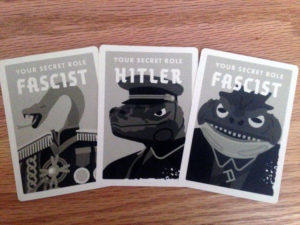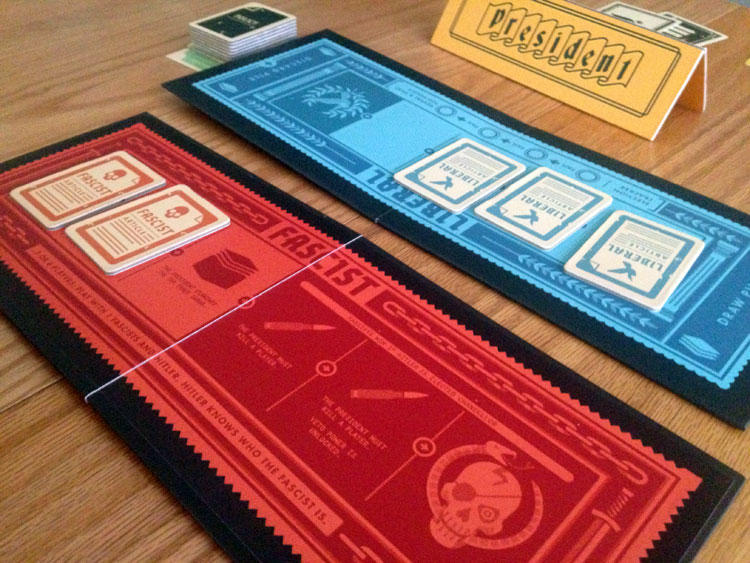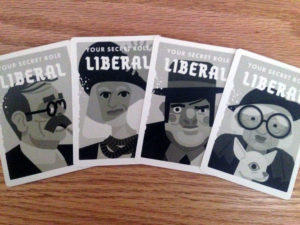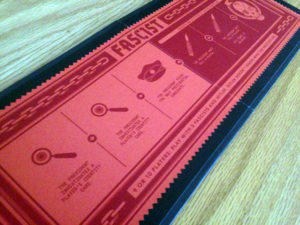Note: This preview uses early components and rules. What you see here may be different from the final, published version of the game.
 There has been a small influx in the last few years of games based on player social interaction. One Night Ultimate Werewolf, Two Rooms and a Boom, Good Cop, Bad Cop are some of the more popular ones. Most of these games are typically classified as party games, but they have become so much more than that label implies.
There has been a small influx in the last few years of games based on player social interaction. One Night Ultimate Werewolf, Two Rooms and a Boom, Good Cop, Bad Cop are some of the more popular ones. Most of these games are typically classified as party games, but they have become so much more than that label implies.
Today we are going to be taking a look at a social deduction game called Secret Hitler, designed by some of the minds who brought us Cards Against Humanity. The kickstarter campaign fully funded at the end of 2015 and created a buzz by blowing away its needed funding by $1.4 million. With the huge success of the campaign and the buzz it generated, I decided I needed to get my hands on a copy of Secret Hitler to see what all the excitement was about. So let’s dive in.
Game Overview:
Secret Hitler is a social deduction game where players are secretly playing members of the two political parties in pre-World War II Germany. Each player will be a member of either the Liberal or Fascist party.
The Liberal team will try to enact 5 liberal policies or assassinate the Hitler player, while the Fascist Team will try to enact 6 fascist policies or elect Hitler as chancellor after the 3rd fascist policy is enacted. Game play continues until either team meets one of their victory conditions.
How to Play:

Secret Hitler can scale from 5-10 players and the number of Liberal and Fascist role cards will depend on the number of players. There will always be less Fascist (and always include Hitler) than Liberal roles no matter the number of players. Every player will be randomly dealt their role, party membership, and two ballot cards in an envelope. Once all players secretly look in their envelopes, President and Chancellor placards are randomly dealt out.
The game then walks the players through a script that allows the Fascist players to know who each other is.
The game is played in a series of rounds, with each round having an Election to form a government, a Legislative Session to enact a new policy, and an Executive Action to exercise governmental power.
Election
1. Pass the Presidential Candidacy: Each new round the Presidential placard moves clockwise to the next player at the table.
2. Nominate a Chancellor: The new President selects a new Chancellor candidate.
3. Vote on the Government: Once the Presidential candidate selects a Chancellor candidate, the whole table votes on the proposed Government. When each player is ready, they extend one of their ballot cards (yes or no) and then all players flip simultaneously. If 50% or more ballots are yes, then candidates are elected. If it’s a tie or less than 50%, then the Presidency placard moves clockwise to the next player and the election tracker is advanced by one. If the table rejects 3 governments in a row, then the top policy is enacted.

Legislative Session
Once a government is formed, the President secretly draws 3 cards from the Policy Deck and discards 1. They then pass the remaining cards to the Chancellor, who secretly discards 1 and then enacts the last card face-up on the corresponding policy track for the table to see. If the Government enacts a Liberal or a Fascist Policy that grants no Presidential power, then begin a new round. If a Fascist Policy was enacted that grants Presidential Power, then move to the Executive Action.
Executive Action
The President must now use the current power that is available on the Fascist Track such as: Investigate Loyalty (check another player’s party Membership Card), Call Special Election (President gives the Presidential placard to a player of their choice), Policy Peek (look at the top 3 cards of the Policy Deck), and Execution (President chooses a player to remove from the game). After the President uses the Executive Action a new round begins.

Game Experience:
I think before I start that it’s important to note the suggested intent of the game. The game exemplifies how a fascist government rose to power in pre-World War II Germany. I know most think that Cards Against Humanity probably aren’t the most politically correct designers, but effort was taken not to be insensitive. The secret role card images exemplify those efforts perfectly. The Fascist cards use cartoon images of in-human, cold-blooded reptiles and the Liberals cards use cartoon images of actual men and women.

Now that said, this was a really fun game that my group and I fell in love with right away. There’s a lot of fun to be had here for gamer and non-gamer alike. Like Cards Against Humanity, this is a good gateway game for non-gamers to enjoy with straight-forward rules. Each player at some level will become President or Chancellor, so player participation and interaction is very high. And since this is a social game, it could definitely win over many a first time players and broaden their gaming horizons.
The high enjoyment also comes from how the developers balanced this game for both teams. As noted above, there will always be fewer Fascist team members than Liberal, but the actual Policy Cards are the reverse. This was key because you could have Liberal players enacting Fascist polices because either they had no choice or because they want to exercise the executive power. This can cause either confusion or a sense of solidarity for the Liberal players because, as noted in the rules at the start of the game, they don’t know who else is on their team.
On the flip side, the Fascists will know who the other Fascists are, so they have an advantage but have fewer members. This leads most Fascist players to bluff and act as if they are on the Liberal team, but all the while giving glances to their allies and sowing confusion into the Liberal ranks.

The last thing that I wanted to note was that the designers created different Fascist Policy tracker boards that scale with the game. The higher the player count and the faster you have Executive Power to use, soon one or two Fascist Polices will be enacted. So again, the game has great balance for each team and each has pros and cons. The effort of the designers shows through every game play, making it very enjoyable and gives the game a high ceiling for replay.
Overall I could not find much that my group or I wanted to change or criticize. The only issue was that the preview was missing an election tracking token or marker. Anything will do in its place. I’m sure the designers will address this by the time it hits retail. I’m just OCD about game components and each game should have their own pieces and be complete.
The only other thing to note is that overall it’s harder for the Liberal team to win at any player count. The 5-6 player count seems even harder for a Liberal win. The odds are stacked against the Liberals in the lower player counts because overall there are fewer players in the actual game. After three Fascist polices are enacted, the chances of accidentally (or purposely [insert sinister laugh here]) nominating Hitler as Chancellor is much greater. This is not a negative, but just a fact for players to be aware of. Honestly, who likes easy games anyway; real gamers like a challenge!
Final Thoughts:

While social “party games” are nothing new to the gaming scene over the last few years, Secret Hitler seems to build upon other game’s successes and possibly surpass them with its unique play. To simply call Secret Hitler a party game is understating its potential as an everyday game. This is a true social deduction game with fun to be had for all involved at any time. If your group is not into social games, then there probably isn’t much here that will win you over. If you group is the opposite though, then you’ll likely have fun – bluffing, tricking and busting your friends.
If Secret Hitler sounds like your type of game, keep an eye out for its eventual release (due in a few months). Being that it’s a social deduction game it should appeal to most, gamer and non-gamers alike. The rules are easy to learn and teach. I am sad that I missed the Kickstarter and honestly can’t wait to get my hand on the final retail version.
As always, we don’t post ratings for preview copies as the components and rules may change from the final game. Check back with us after the game is produced for a full review.





















How does it compare to The Resistance? There’s more going on in Secret Hitler do those additions tip the game in favor of one side?
Hi Wayne- it’s similar in the sense that’s there’s two distinct teams and through social deduction your trying to root out who is who. The elimination element is what really separates Secret Hitler from Resistance. Losing a team member can be a huge swing or even game winner for Secret Hitler. And yes, the Fascists seem to have the advantage from my game experience since they know team members and need to enact less Fascist policies to win. But it’s a good time for all since you will likely play multiple games so most players should see what it’s like to play either team.
Looks like the retail version is out -found it on Amazon: https://www.amazon.com/Secret-Hitler/dp/B01JKD4HYC/ref=cm_cr_arp_d_product_top?ie=UTF8